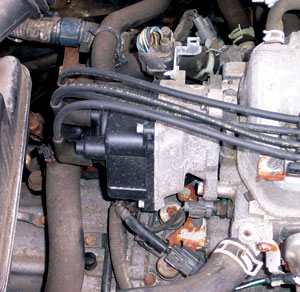INCREASING IGNITION SYSTEM SALES
Many veteran parts professionals remember when replacing contact points, condensers and spark plugs was required annual maintenance. But during the 1970s, electronic ignition systems did away with all that.
 Advances in engine fuel control and the introduction of unleaded gasoline also began extending the service life of most spark plugs well into the 30,000-mile range. By the early 1990s, auto manufacturers had introduced long-life spark plugs with extended service lives of at least 100,000 miles. When the “100,000-mile tune-up” became commonplace, many throughout the automotive service industry predicted that ignition sales were becoming a declining market.
Advances in engine fuel control and the introduction of unleaded gasoline also began extending the service life of most spark plugs well into the 30,000-mile range. By the early 1990s, auto manufacturers had introduced long-life spark plugs with extended service lives of at least 100,000 miles. When the “100,000-mile tune-up” became commonplace, many throughout the automotive service industry predicted that ignition sales were becoming a declining market.
A PROFITABLE MARKET
Fortunately for most jobbers, perception is not reality. By the 2000 model year, it seemed like ignition parts sales were, indeed, becoming a declining market for many jobbers and retailers. But we can’t analyze markets by comparing apples to oranges. The apples in this case are the relatively inexpensive ignition parts of a decade ago and the oranges are the expensive ignition parts of today.
To illustrate, conventional distributor ignition systems used one coil to supply spark to all of an engine’s cylinders. Modern waste-spark distributorless ignitions use one coil per two cylinders, with a typical V6 engine having three coils and a V8 having four coils. Coil-on-plug designs incorporate one coil per cylinder. Simply put, modern technology has, depending upon application, increased potential ignition coil sales by multiples.
Similarly, many veteran parts professionals recall when the wholesale price for an average spark plug application was slightly less than a dollar. Today, the average wholesale price of a long-life spark plug can be $10 or more for many applications. So, when we’re talking about the ignition market, let’s talk about dollars and cents instead of unit sales.
PRIMARY AND SECONDARY IGNITION DEFINED
To understand the ignition market, we need to understand the language. Primary ignition parts like crankshaft sensors, camshaft sensors, magnetic pickup coils for distributor ignitions and ignition modules are those that operate at or near battery voltage. The ignition coil is an exception because it operates with a primary and secondary winding, with the primary winding operating at 12 volts and the secondary at 12,000 to 60,000 volts.
It’s important to understand that the replacement of primary ignition parts isn’t part of any auto manufacturer’s normal scheduled maintenance. While some shops might replace primary ignition as a preventive measure on older vehicles, most primary ignition is replaced only when the original component fails.
In contrast, secondary ignition parts are expendable units because the secondary winding of the ignition coil generates a high-voltage spark that ranges between 12,000 and 60,000 volts, depending upon application and operating conditions. This extremely high voltage wears away spark plug electrodes and tends to burn through or erode secondary ignition parts like ignition coils, distributor caps, rotors and wires.
CATALYTIC CONVERTERS AND IGNITION MISFIRES
The most important rationale to selling quality ignition parts is to prevent an engine misfire from damaging expensive catalytic converters. Because catalytic converters are designed to burn gasoline and other hydrocarbons left over from the combustion process, an ignition misfire can cause excessive amounts of hydrocarbons in the form of unburned oxygen and gasoline to enter the catalytic converter. When this happens, the converter core will melt, causing the check engine light to illuminate and the vehicle to fail an exhaust gas emissions test.
So, when serving your amateur or professional mechanic, always remind them that all modern ignition products are designed to prevent potential misfires from damaging the vehicle’s expensive catalytic converter.
SPARK PLUGS
Let’s start by saying we should think twice before we reduce our profitability by substituting conventional spark plugs for the more expensive long-life spark plugs. Sure, the customer’s mistaken belief that he’s saving money might be driving the sale, but the long-term consequences might include a steel-shell spark plug permanently seizing into an aluminum cylinder head or an expensive catalytic converter destroyed by an inexpensive set of misfiring spark plugs.
Of course, some vehicles still require only a conventional spark plug spark that must be replaced at 30,000- or 60,000-mile intervals. Beyond those applications, the long-life spark plug should be sold exclusively to prevent damaging expensive aluminum cylinder heads and catalytic converters.
The sale can be made much easier if you ask your customer to compare the cheapest spark plug in your inventory with the most expensive. The customer will see at least three major differences. First, the threads of the expensive spark plugs will be plated with nickel or similar materials to prevent the spark plug from seizing in aluminum cylinder heads.
Second, the center electrode will be very pointed and perhaps needle-like in configuration to help the spark to jump the air gap between the electrodes much more efficiently. Third, the electrodes will be plated or contain precious metals like platinum, palladium or iridium, which drastically reduces electrode wear. All of these features combine to provide a steady, consistent spark that reduces misfire emissions and lengthens catalytic converter life.
Last, considering poor accessibility to the spark plugs on many modern engines, it’s simply not cost-effective to spend three hours or more replacing a set of long-life spark plugs with a set of conventional spark plugs. The secret to selling long-life spark plugs is to help the customer understand the benefits of long-life spark plugs and the reasons the auto manufacturer requires long-life spark plugs in that application.
SPARK PLUG WIRES AND BOOTS
Some manufacturers recommend replacing spark plug wires at specified intervals. For example, the owner’s manuals of many late ‘90s Chrysler products recommend replacing spark plugs and spark plug wires or cables at 60,000-mile intervals. Here again, this recommendation is driven by the need to prevent damaging the catalytic converter by eliminating the potential for ignition misfires.
While wire replacements aren’t generally specified in most auto manufacturer’s scheduled maintenance charts, real-world conditions dictate that wires should be replaced along with the spark plugs at 100,000-mile intervals. In many cases, the wire’s boots seize to the spark plugs and can easily break when the wires are removed. Consequently, selling a set of wires to go with the new spark plugs isn’t as much over-kill as it is good preventive maintenance.
But the most fundamental reason for replacing wires and spark plugs at the same time is to prevent flash-over spark leakage from occurring. Because air gap voltage increases as the spark plug wears, the high-voltage spark seeks the path of least resistance and eventually begins to leak down the side of the external spark plug insulator. This leakage causes a black carbon track to form on the spark plug’s external insulator and, if we look inside the spark plug boot, we’ll see a carbon track that matches the one on the spark plug. If the wire or boot isn’t replaced, high secondary voltage will continue traveling down the track or “flashover” in the boot, causing a misfire that might damage the catalytic converter.
Most production resistor spark plug wires are made with a tough core impregnated with carbon particles.
This type of core eliminates electronic emissions that interfere with radios and sensitive electronic circuitry. The core is further coated with a flexible silicone-based material that insulates the wire by containing high secondary ignition voltages. The outer layer basically protects the inner core from being damaged by atmospheric pollutants, oil and abrasion. Wires are made in sizes that include the 6-millimeter wires used on many Toyota products to the standard 7- and 8-millimeter diameters used on many distributor and distributorless ignition systems.
But, regardless of how well-made the original wire might be, heat, oil, ozone, and high voltage will eventually increase the fragility of the wire. Indeed, many old wires fail shortly after the spark plugs are replaced simply because the very act of tugging them off the spark plug has separated the wire internally or cracked the wire or boot. OE wires should be replaced with wires of comparable quality. Given the difficulties of access and current labor rates, installing cut-rate spark plug wires isn’t always a cost-effective repair. Because a secondary ignition failure illuminates the “check engine” light on the instrument cluster on modern vehicles, the failed wire can’t be covered up or concealed. It can only be replaced with a quality ignition wire, as it should have been in the first place.
Gary Goms is a former educator and shop owner who remains active in the aftermarket service industry. Gary is an ASE-certified Master Automobile Technician (CMAT) and has earned the L1 advanced engine performance certification. He is also a graduate of Colorado State University and belongs to the Automotive Service Association (ASA) and the Society of Automotive Engineers (SAE).











